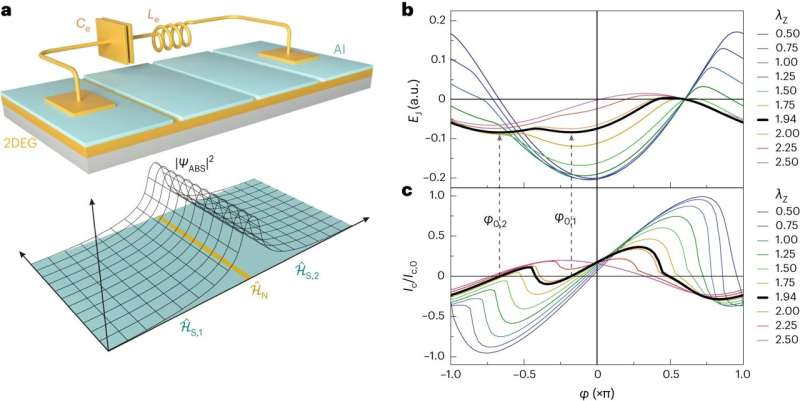This article has been reviewed according to Science X's editorial process and policies. Editors have highlighted the following attributes while ensuring the content's credibility:
fact-checked
peer-reviewed publication
proofread
Physicists demonstrate sign reversal of the Josephson diode effect

Physicists at the University of Regensburg (UR) led by the research groups of Professor Dr. Christoph Strunk / Dr. Nicola Paradiso and Professor Dr. Jaroslav Fabian made an exciting discovery: In their publication just published in Nature Nanotechnology, the research teams experimentally demonstrate a dramatic sign change of the supercurrent diode effect. The corresponding experimental data are in quantitative agreement with the theory of Dr. Andreas Costa, also a physicist at the University of Regensburg.
Most transistors, including the building blocks of computer's CPUs, generate heat. This is, because most conductors are resistive, leading to Joule heating. Indeed, there are special transistors which do not generate heat, the so-called "Josephson junction field effect transistors." They are based on the Josephson junction, a weak connection between two superconductors, which still carries a zero-resistance current (or supercurrent).
After its discovery by Nobel Prize winner Brian Josephson, Josephson junctions quickly found applications in various fields such as medicine, metrology, and astrophysics. More recently, they became key components of quantum computers, since they are at the heart of transmons, the most popular qubit implementations in superconducting quantum processors.
In light of the above, one can understand the attention generated by the discovery of the first superconducting diode based on a Josephson junction made in 2021 in the group led by Nicola Paradiso and Christoph Strunk at the University of Regensburg in a synthetic crystal grown by Michael J. Manfra and his team at Purdue University.
The excitement arises from the potential for superconducting diodes to serve as the basic building blocks for new types of superconducting circuits, for a future replacement of resistive circuits by superconducting ones.
The distinctive property of an ordinary semiconducting diode is its asymmetry: its resistance can be very high or very low depending on which of its two terminals is connected to the cathode and which of on the anode of your battery. This asymmetry leads to the diode's most important property: current rectification.
Instead, a superconducting diode exhibits no resistance, so its working principle must be different. What Paradiso and his colleagues have found is that a superconducting diode shows different inductance for the two possible DC current polarities. Also, for the polarity for which the inductance is lower, the observed critical current (that is, the current threshold that makes the device switch to resistive state) is higher. We can call this the preferred current direction.
But what decides about the preferred direction? The answer was considered a fixed materials characteristic.
Most recently, UR's researchers made an exciting discovery: At a larger magnetic field, the preferred direction can reverse. Interestingly, theoreticians have predicted this effect about 10 years ago, but it was never observed so far. In a paper just appeared in Nature Nanotechnology, the Strunk group experimentally demonstrates a dramatic sign change of the supercurrent diode effect, with experimental data that quantitatively match the theory by Dr. Andreas Costa, also from Regensburg.
This discovery will certainly have a major impact in the scientific community, as the superconducting diode effect became a hot topic in quantum electronics due to its exciting perspectives for technological applications and fundamental research.
More information: A. Costa et al, Sign reversal of the Josephson inductance magnetochiral anisotropy and 0–π-like transitions in supercurrent diodes, Nature Nanotechnology (2023). DOI: 10.1038/s41565-023-01451-x
Journal information: Nature Nanotechnology
Provided by Universität Regensburg





















